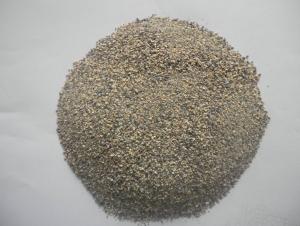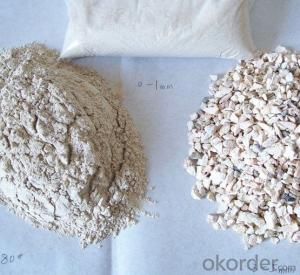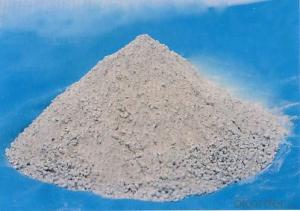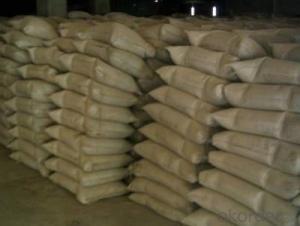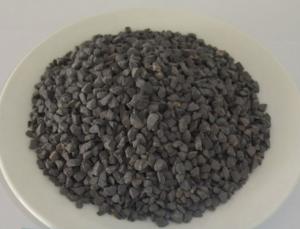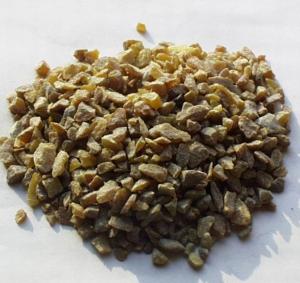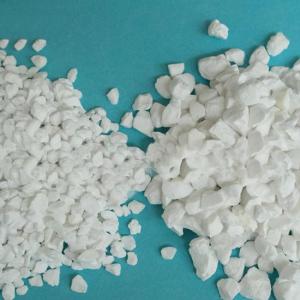Raw Materials for Refractory:Refractory Grade Calcium Aluminate High Alumina Cement Price
- Loading Port:
- China main port
- Payment Terms:
- TT OR LC
- Min Order Qty:
- 25 m.t.
- Supply Capability:
- 2000 m.t./month
OKorder Service Pledge
OKorder Financial Service
You Might Also Like
Specifications
high alumina cement
1.Bindering materials
2.Use to refractory
3.long setting time
4.resist high temprature
refractory grade calcium aluminate high alumina cement price
Features:
1. High refractoriness
2. Stable chemical properties, good chemical corrosion performance
3. Ideal plasticity
4. Low shrinking
5. High binding strength, good structural integrity
6. Long service life
Application:
1. Mainly used for the masonry of high-alumina refractory bricks and repairing kilns.
2. Steel, cement, and ceramic industry
3. Power and chemical Plants
4. Petrochemical industry and foundries.
Specification
Items | Unit | Index | ||
CA-70 | CA-80 | |||
Chemical composition | Al2O3 | % | 68.50-72.00 | 78.50-81.00 |
CaO | % | 28.0-31.50 | 17.00-20.00 | |
SiO2 | % | ≤0.50 | ≤0.50 | |
Fe2O3 | % | ≤0.50 | ≤0.40 | |
K2O+Na2O | % | ≤0.50 | ||
Specific Surface Area | cm2/g | ≥5000 | ≥7000 | |
Beginning Set | min | 40-150 | ≥30 | |
Bending Strength | 24h | Mpa | ≥7.0 | ≥5.50 |
Compressive Strength | 24h | Mpa | ≥45.0 | ≥40.00 |
Refractories | ≥1560 | ≥1790 | ||


- Q: A chemical problem with refractory materials
- Not necessarily. What you mean is silicate
- Q: What are unshaped fire-resisitance materials?
- Refractory castable, refractory plastic material, usually classified according to construction and manufacture method, unfired bricks precast block, refractory pressed into material, refractory cast material, refractory coating, refractory ramming material there are many classification methods
- Q: Which brand of thermal insulating refractory is good?
- Brands of thermal insulating refractory: 1, Armaflex(German brand). Manufacturer: Armacell thermal insulation materials (Guangzhou) Co., Ltd, Armacell thermal insulation materials (Suzhou) Co., Ltd. 2, Durkflex (American brand) Manufacturer: Durkee (Guangzhou) thermal?insulation?material Co., Ltd. Durkee (Wuhan) thermal?insulation?material Co., Ltd. 3, Aeroflex (Thailand Brand) Manufacturer: Aeroflex Polymer Technology (Shanghai) Co., Ltd.
- Q: How is the grading of the level A new material fire insulation material?
- The thermal insulation materials are generally divided into level A and level B according to the flame rating. Level A is the non-combustible material, and level B is the combustible materials. The level B material is to blame for the fire in Shenyang hotel in CCTV building a few years ago . At present, the level A materials are widely used, with some prices even cheaper than the level B material. A level is roughly divided into insulation mortar, phenolic board, rock wool board and foam cement board, ect.
- Q: What are the basic requirements of continuous casting for molten steel? What are the requirements for refractory materials?
- The rapid development of the technology of continuous casting refractories so the corresponding development and improvement in variety and quality, continuous development of refractories for the continuous casting billet continuous casting production and quality have a significant impact. Especially, the completion and operation of Baosteel have greatly promoted the technological progress of refractory materials in China, and the refractory materials for continuous casting have made great progress both in variety and in quality.
- Q: What are the specifications of fire resistant bag?
- Mesh number, namely hole number, refers to the hold number in each square inch. 5o mesh refers to 50 holes in each square inch and 500 mesh 500 holes. The larger the mesh number is, the more the holes are. The larger the mesh number is, the smaller the hole aperture is. Generally speaking, mesh number× aperture (microns) = 15000. For example, the aperture of a sieve of 400 mesh is about 38 microns; the aperture of a sieve of 500 mesh is about 30 microns.
- Q: how to classify Insulating Refractory ?
- We are glad to answer your questions! This one is professional. My advice is to go through relevant webs for reference.
- Q: what is the Specifications Grading for Fireproof rubber insulation materials ?
- At present, China Building Materials has two grading criteria for combustion performance. "Combustion Performance Classification Method of Building Materials" and "Combustion Performance Classification Method of Building Materials and Products" (GB8624-2006). Among them, one of the major changes of GB8624-2006 and GB8624-1997 is to divide the material combustion performance grading from homogenous material)Class A (composite sandwich material), B1, B2 and B3 level five minutes as A1, A2, B, C, D, E, F seven levels.
- Q: what is the specs of thermal insulation refractory slab ?
- thermal insulation refractory slab features wear proof, heat resistance, impact resistance, acid or alkali resistance, smoke resiatnce, fire proofing,fungi proofing, mould proof,anti-static. fireproof panel is generally used for countertops, tabletops, walls, cabinets, office furniture, wall hung cupboard. Common Specifications: 2135mm × 915mm, 2440mm × 915mm, 2440mm × 1220mm, thickness 0.6-1.2mm.
- Q: Are refractory materials and fireproofing materials the same?
- The refractory material and fireproofing material are not the same in the strict sense. Refractories refer to non-metallic materials of which refractoriness are higher than 1580 degrees. Now commonly used heat insulation materials can also be considered as refractory materials. The fire endurance of fireproof materials reaches certain requirements. Its test temperature is 540 degrees. Range of applications for two material are not the same. Refractory materials can be used in high-temperature region as it can withstand high temperature. Fireproof materials can not be used under high temperatures for a long time.
Send your message to us
Raw Materials for Refractory:Refractory Grade Calcium Aluminate High Alumina Cement Price
- Loading Port:
- China main port
- Payment Terms:
- TT OR LC
- Min Order Qty:
- 25 m.t.
- Supply Capability:
- 2000 m.t./month
OKorder Service Pledge
OKorder Financial Service
Similar products
Hot products
Hot Searches
Related keywords





